Article by Snorri Páll Jónsson Úlfhildarson, originally published in The Reykjavík Grapevine. Photos: Stills from the film.
It’s dark and silent — nothing unusual around midnight by river Laxá and lake Mývatn in the north of Iceland. But somewhere behind the darkness, beneath the silence, something extraordinary is about to happen. Suddenly, a dynamite explosion disturbs the silence — in what has gone down in history as a single yet highly important step in a much greater movement of resistance.
More than a hundred farmers officially claimed responsibility for the explosion, which annihilated a small dam in the river on August 25, 1970. The area’s inhabitants were determined to prevent the construction of a much bigger dam, which would have destroyed vast quantities of this natural area, as well as most of the surrounding farmlands.
Just as determined to keep the saboteurs away from legal troubles, those who claimed responsibility kept a strict policy of silence, making it hard for the authorities to single out alleged leaders or protagonists. Now, almost half a century and a saved river later, another bang has broken that silence.
A WATERSHED ACT IN ICELANDIC HISTORY
Namely, that is Grímur Hákonarson’s documentary ‘Hvellur’ (“Bang” — see trailer below), which premièred at the Bíó Paradís cinema on January 24. Through dialogues with some of the participants, many of whom still reside by the river, the film tells the story of the Laxá conflict. “We kept all commentators and university professors out,” Grímur told me a few days before the première, “focusing instead entirely on those who took part in it.”
The case is often considered the beginning of environmentalism in Iceland. Shortly thereafter, Nobel Prize-winning author Halldór Laxness wrote his famous, hard-headed call-out for nature conservation — titled ‘The Warfare Against the Land’ — and the Laxá conflict also brought about the Environmental Impact Assessment, which up until then had been completely absent in Iceland’s energy production.
“What makes the Laxá conflict peculiar is that those who resisted also succeeded,” Grímur says. “The planned dam was never built and the area was saved.” Four years later, parliament passed a law securing the protection of Laxá and Mývatn, contributing to the explosion’s status as “the most remarkable and powerful event in the history of environmentalism in Iceland,” as Sigurður Gizurarson, the bomber’s defence lawyer, put it.
Celebrating the forty-year anniversary of the act in August 2010, one of Iceland’s most remarkable environmentalists, Guðmundur Páll Ólafsson, remarked that the act “literally saved the ecosystem of Mývatn and Laxá.” He also maintained that the dynamite “blew up a democracy-restriction imposed on the district’s inhabitants and all those who loved the land, by the authorities and the board of Laxárvirkjun,” the company that owned the dam. “The arrogance of the authorities hovered over the land until the bomb exploded, but then we became free — for a while.”
Sixty-five people were charged for sabotage, but no one spoke out about any details and the Supreme Court ended up handing out mild suspended sentences. The film now reveals that three men were responsible for igniting the dynamite. Only one of them is still alive.
STILL THE BONE OF CONTENTION
In any case, exposing secrets is much less the film’s aim than documenting and preserving this extraordinary story. And for a good reason — it could easily fall into oblivion. “People over fifty remember this event very well, but those who are younger don’t really know the story,” Grímur says, adding that during the film’s making, they were told numerous times that they should have started filming much earlier as many involved have since passed away.
But how do those still alive recall these events today? “No one looks back regretfully, and most of them are still politically radical, opposed to large-scale destruction of natural areas for energy production. They are proud of the results of their act,” Grímur says.
But as Guðmundur Páll’s words, “then we became free — for a while,” imply, the plans had not been cancelled for good. During the construction of the huge Kárahnjúkar dams in Iceland’s eastern highlands, a new construction plan for Laxá was put on the drawing table. However, as words of warning came from Mývatn — including that the locals surely hadn’t forgotten how to use dynamite — the plans were later drawn back. Siv Friðleifsdóttir, then Minister of the Environment, stated that never before had she been so pleased to cancel a project.
Many of Iceland’s most remarkable natural areas are still the bone of contention between environmentalists and industrialists, including geothermal areas close to Mývatn [see here and here]. Grímur doesn’t consider the film to be part of the current conflict, but it doesn’t mean that people won’t feel some connection with today’s most pressing environmental issues. “One only needs to listen to the debates in parliament,” Grímur concludes, “to notice that the same old discussion is still going on today.”
___________________________________________________________________
HVELLUR from Ground Control Productions on Vimeo.
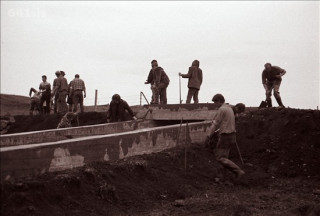
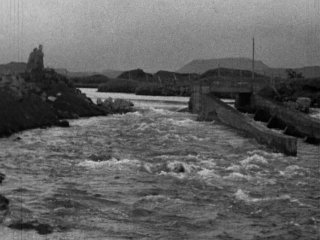
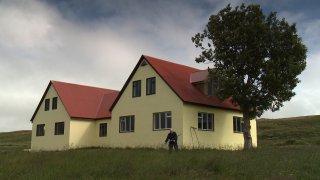
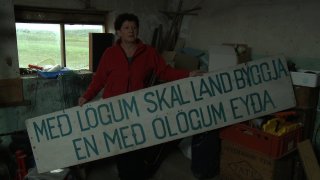
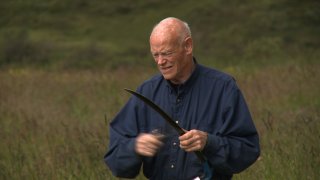
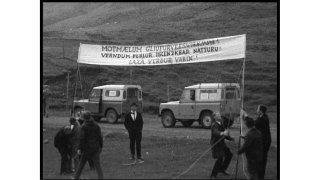
Hello,
I am a researcher in USA studying the Laxá conflict. Is there currently an English translation of HVELLUR?
Thank you,
M Jackson
Yes, so it seems:
http://www.icelandicfilms.info/films/nr/1477
Two relevant links:
The film with English subtitles is available for free at: https://www.cultureunplugged.com/documentary/watch-online/play/53514/The-Lax—Farmers
And this blog post has some brief notes on the film: https://lowanaveal.wordpress.com/2013/01/30/when-locals-blew-up-a-dam/
Thanks for this page; there doesn’t seem to be much information online about this incident, which deserves to be better known!